Yesterday, I used what was likely one of the last warm days of the year to tackle all of the issues that stacked up in my wife’s 2012 Scion iQ. The little bugger was getting abysmal fuel economy, sometimes stalled out, and, on basically every other day, its gas pedal also had a knack for breaking, preventing the vehicle from moving anywhere. We fixed all of the issues, making the car drive better than it did when we picked it up. But getting to the finish line was ridiculous because Toyota gave this tiny car the dumbest possible route to get to the spark plugs.
Now, for various silly reasons having to deal with how a site like the Autopian works, “My” works better in a headline than “My Wife’s.” However, she chose the car herself and then bought it with her own money. The car is in our shared fleet, yes, but it’s mainly her ride. She also maintains her own car as a point of pride. However, I know more about wrenching than she does, so when it came to this project, I coached her on how to do everything. I spun very few wrenches this time around!
I’ve written about this car quite a lot by now, so if you want its full story, click here to start bringing you up to speed. Otherwise, I’ll keep it short. Sheryl picked up this 2012 Scion iQ in December 2023 with 67,000 miles. Her idea was to get something that was as cute as a Smart, but as reliable as a Toyota. Thus far, the car has largely lived up to that promise. We’re just about to hit the two-year mark with this car, and it’s going to cross 60,000 miles in her care. That’s 30,000 miles a year for those of you counting. Thankfully, she is driving fewer miles than she used to. Her previous cars sometimes got as many as 40,000 miles a year.

What Broke The First Time
The only modifications that Sheryl has done to this car are an Android Auto and Apple CarPlay stereo, a center console, wheels from a Scion iA, and an aftermarket cruise control. The stereo and the center console were great, but the cruise control was not.
The cruise control worked flawlessly until nearly a year after our local Toyota dealer installed it. Then, out of nowhere, the accelerator pedal — which is drive by wire — stopped working intermittently. The symptoms would be that Sheryl or I would mash the gas pedal, but absolutely nothing happened. The car would sit completely still. Alternatively, the engine would rev to redline, but the car would move only 10 mph. Finally, one more failure mode was just that the car went into limp mode.

The accelerator pedal failure was accompanied by a P2122 error code, plus the activation of the Maintenance Required light plus the Traction Control Off light.
Diagnosis at our local Toyota dealer revealed that the aftermarket cruise control unit had failed. You’d think that this shouldn’t matter for the gas pedal, but the twist is that the cruise control ties into the pedal’s wiring to do its job. It was the dealer’s diagnosis that the faulty cruise sent bad signals to the digital pedal, ultimately killing it.

So, the dealer replaced the cruise and the pedal. We were extremely disappointed when, 10 months later, or around October, the brand-new pedal began dying just like the last one. This time, thankfully, the failure mode did not include revving to the moon. But the car would just stop responding to throttle input at completely random times, even at highway speed.
Wrenching Day
This time, we decided to uninstall the cruise control entirely. Clearly, either this car shouldn’t have cruise control, or the quality control for these aftermarket cruise units is abysmal. Either way, it has to go. The car was perfectly reliable until this bad modification.

By this time, the car had gathered 123,000 miles, and some other issues had also reared their ugly heads. For one, there have been times when the car got a frankly pathetic 23 mpg. Also, the car had a knack for gently misfiring. On top of this, there have been many times when the engine would just stumble and shut off while idling at a red light. Also, you could hit the gas at a green light, and the engine would rev a little, stall out, and shut down.
My diagnosis pointed towards the spark plugs, which, based on the records I had access to, were original to the car. At 123,000 miles, it was time for them to go. I also decided to replace the ignition coils, too, and you’ll see why in a moment.

Yesterday, Sheryl and I finally got the time to tackle this project. Between October and today, she put 3,000 more miles on the car. Wowie, that’s a lot of driving.
Now, replacing a gas pedal and some spark plugs normally wouldn’t be much of a “project.” The gas pedal is held on with two bolts and can be removed and replaced in an honest 5 minutes. Also, when was the last time you took longer than maybe 30 minutes to remove and replace some spark plugs?

Unfortunately, Toyota engaged in some funky engineering in order to build the world’s smallest four-seat car. Unlike a Smart Fortwo, the Scion iQ – which was sold elsewhere as a Toyota iQ – doesn’t stuff its engine in the back where you would normally find the car’s trunk. That couldn’t happen here because that would mean that there would be an engine where the rear seats are. So, Toyota put the engine up front. However, because the iQ was designed to be almost as small as a Smart, Toyota had to reengineer much of the engine bay to get everything to fit into such a compact space. Here’s what I wrote in the past:
Toyota used some clever engineering to make a car about 10 feet long and 5.5 feet wide fit four people. The automaker says a lot of the tricks went into the vehicle. To maximize interior volume, Toyota punched the wheels out to as far near the edges as they could be. To facilitate this up front, the differential was moved forward of the engine, placing the centerline of the wheels slightly ahead of the engine.
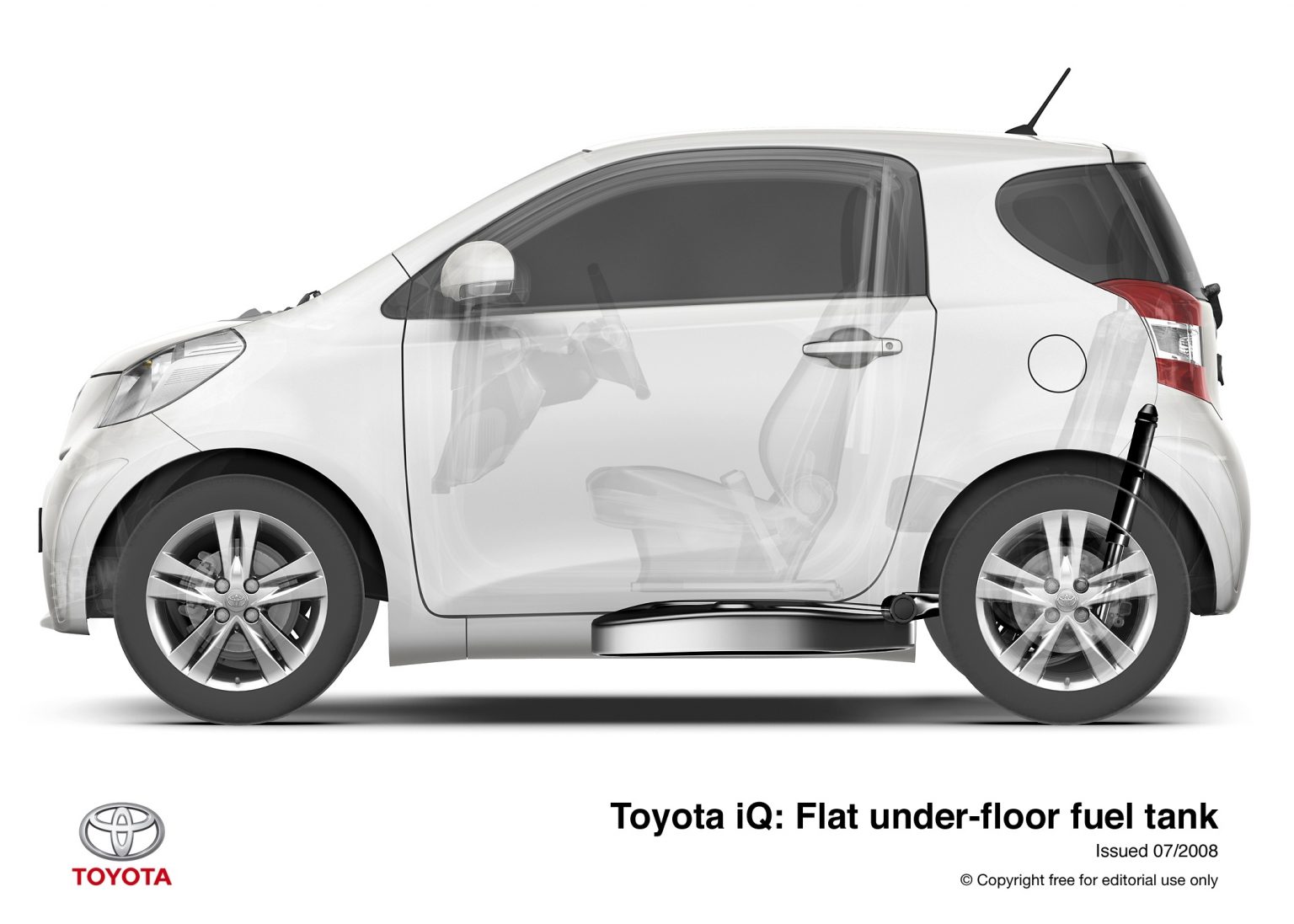
Another space-saving development happened with the steering gear. In other Toyota small cars, tie rods connect to the ends of a conventional rack and pinion. In the iQ, the rods connect to the center of the steering gear. Toyota says this allows the steering rack to sit back near the firewall, reducing front overhang and saving space in the engine bay.
The engineering didn’t stop there. The iQ uses a flat fuel tank that resides under the floor, roughly in front of the rear seat and under the driver seat. Other space-saving measures included the aforementioned air-conditioner pack, which was reduced in size by 20 percent, that weird dash, which is slimmer on the passenger side for more legroom, and seats slimmed down to barely thicker than what you’d see on a bus so that rear passengers could have a place to put their knees. The glovebox was also deleted for even more room.
Unfortunately, this clever engineering means that not only do you not have much space to work on the iQ’s engine, but many of its components are stacked on top of each other. If you pop the hood on a typical car, the only thing blocking you from the spark plugs and coil packs might be an insulating engine cover. In an iQ? You have to take off the throttle body, airbox, and intake runners. This is non-negotiable, too, as the intake sits directly on top of the ignition coils.
Two Paths, Both Silly
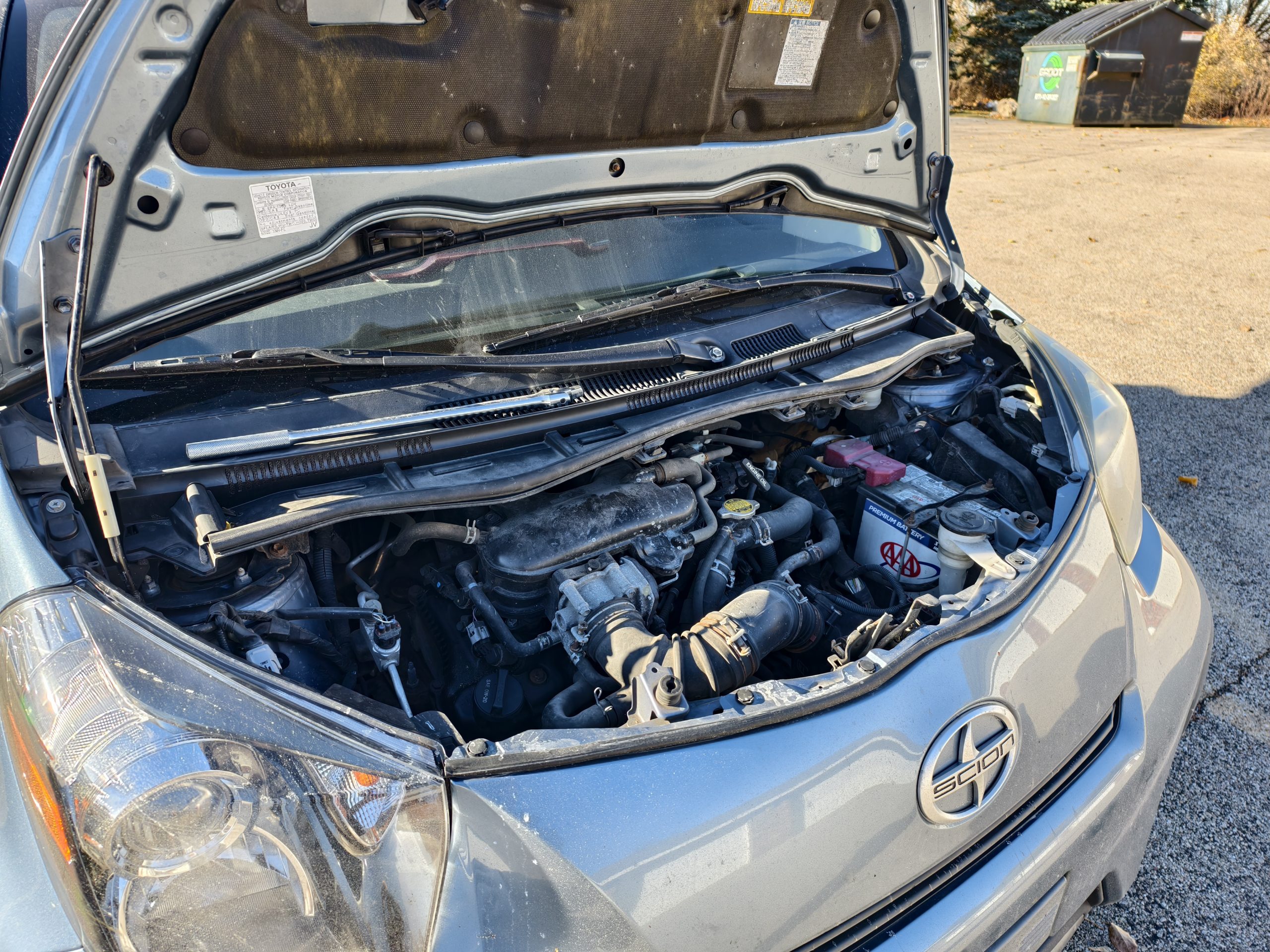
There are two methods for removing the intake from the engine. Since the engine bay is packed so tightly, you can’t just remove the intake. No, that would be too easy. The intake’s bolts are set about 10 inches or so under the header panel that your windshield wipers are attached to. Oh, and one of the bolts is between two of the intake runners, and you have about an inch or so of total space to fit a tool into it.
The “easy” method would be to attach a universal joint to the end of a 12-inch extension and then work on the intake’s bolts from a distance. Unfortunately for me, my universal joint was too thick to reach the bolt between the runners, so that method was out. Here’s a great video on the whole process:
The long way around involves removing the windshield wipers, removing the plastic panel under the wipers, removing the metal header panel, and then finally starting on the intake. So, we did that. Or, specifically, I coached Sheryl on how to do it herself.
Removing the wipers was easy enough. They’re held in with two 14mm nuts. Sheryl removed those with ease, and then immediately lost my 14mm deep socket. We never saw it again.
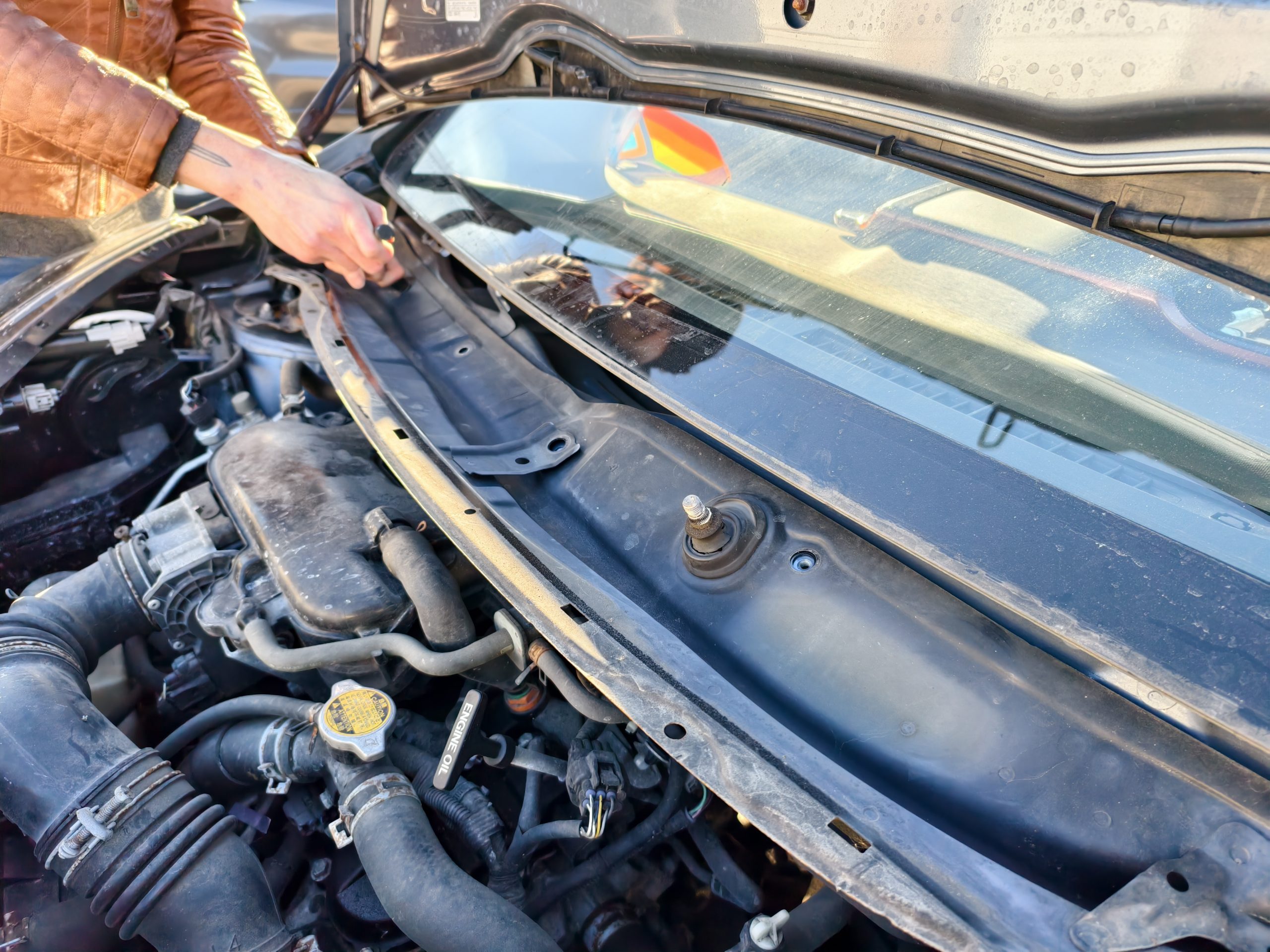
The plastic panel under the wipers was also easy to remove. It’s held in with plastic rivets, and after 13 years outside, they disintegrated the second we touched them.
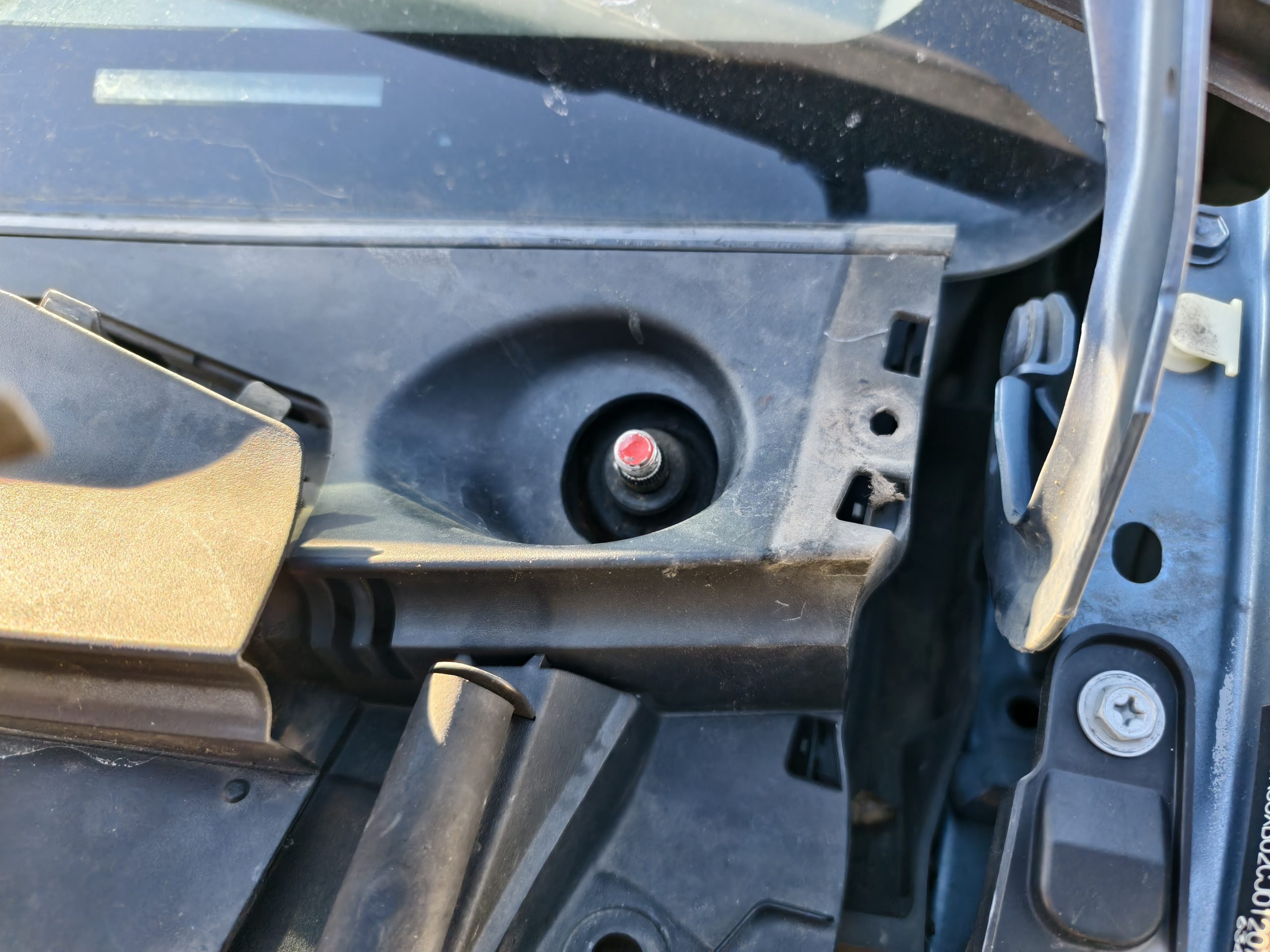
Next came the metal panel, and this one was also easy to remove, as it consisted of a handful of easily accessible 10mm bolts.

Now, with the cowling deleted, the engine bay actually became surprisingly roomy. I was able to see just about everything in the engine bay, except for my missing socket.
The intake is held on with two nuts and three bolts in the rear. These will be easy to get off with just a regular socket and an extension. That pesky center bolt had too little room to fit a socket, so we used a regular ol’ wrench to bust that one out. You’ll find a bracket at the front of the intake, which has two more easily accessible bolts.
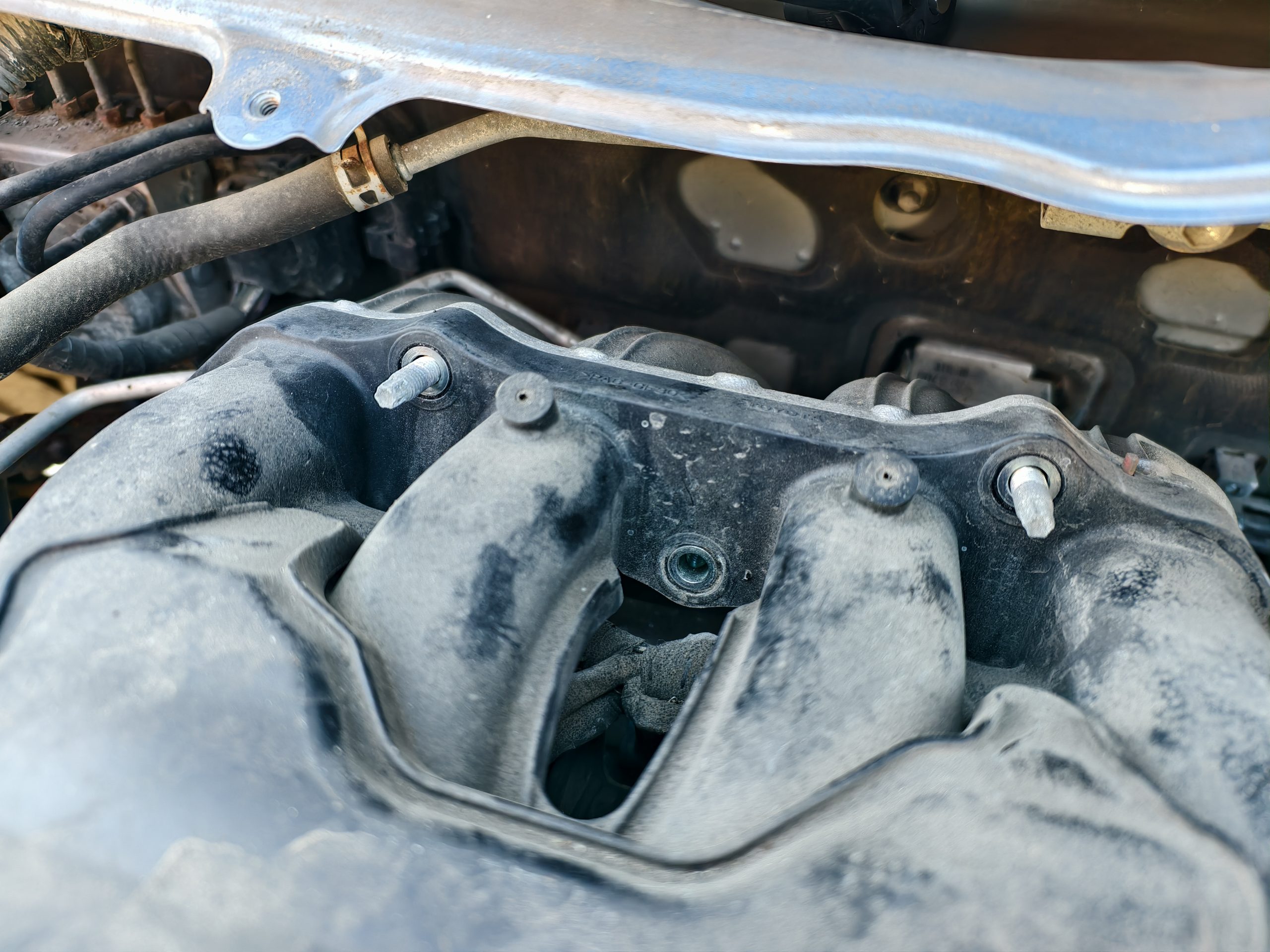
Once all of those bolts and nuts are zipped off, you’ll want to remove all short hoses and electrical connections to the intake. So, you’ll need pliers to work with the clips.
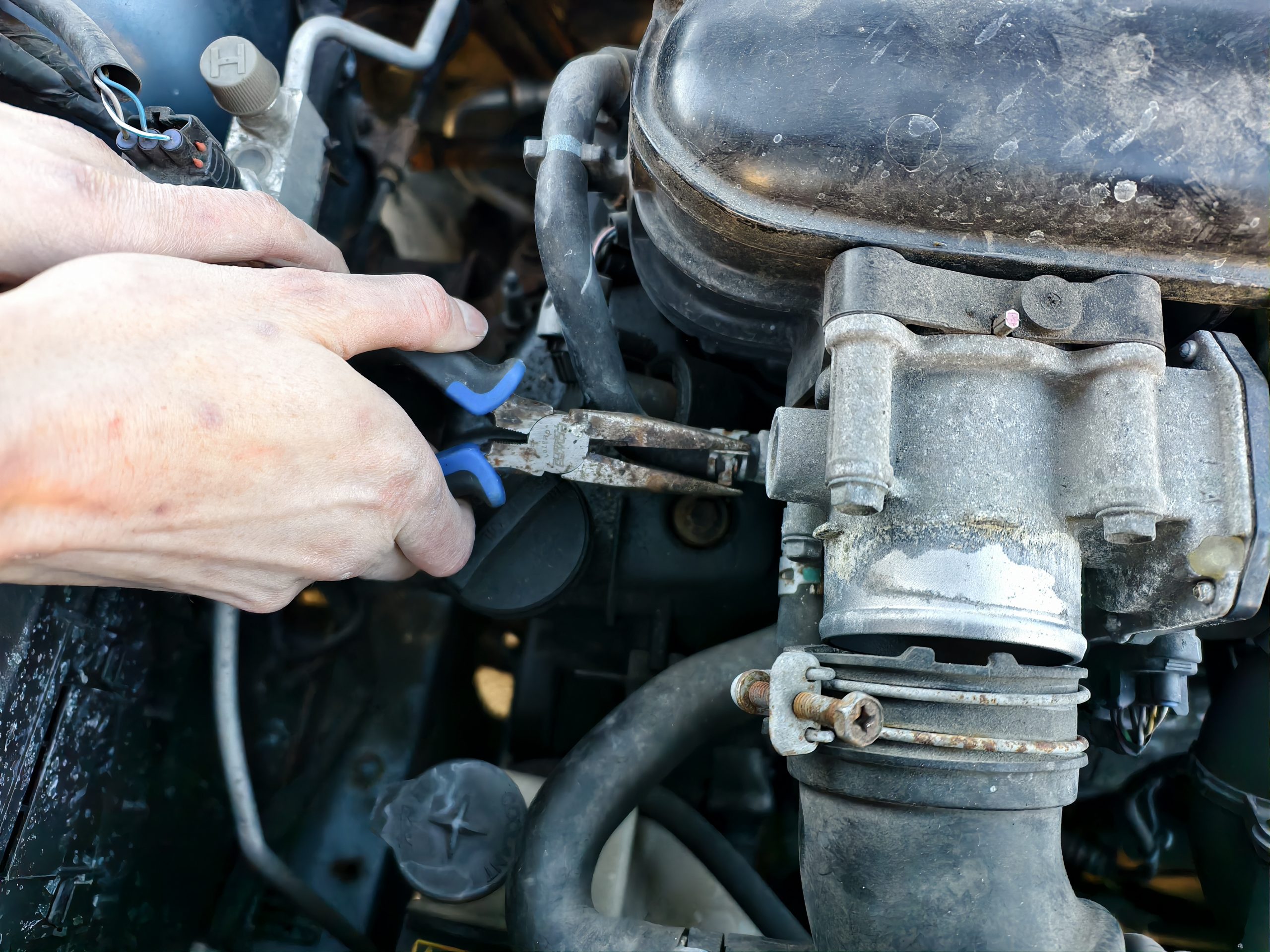
Once you get through all of that, you can finally move the intake away and reach your ignition coils. Take this moment to clean your intake and your throttle body while you’re in there.
It took us about an hour to reach this point. Most of it was because we were working on a car that had spent its entire life in the Rust Belt. Some bolts didn’t want to move, and the hoses weren’t very pliable, either. Also, it was our first time doing this. I bet that you could get this time down to about 30 minutes.

Anyway, removing the ignition coils and spark plugs was super easy, barely an inconvenience. The coils looked okay, and tested okay, too.
Yep, That’s Your Problem
And the plugs? Oh yeah, they were well-worn. Take a look:
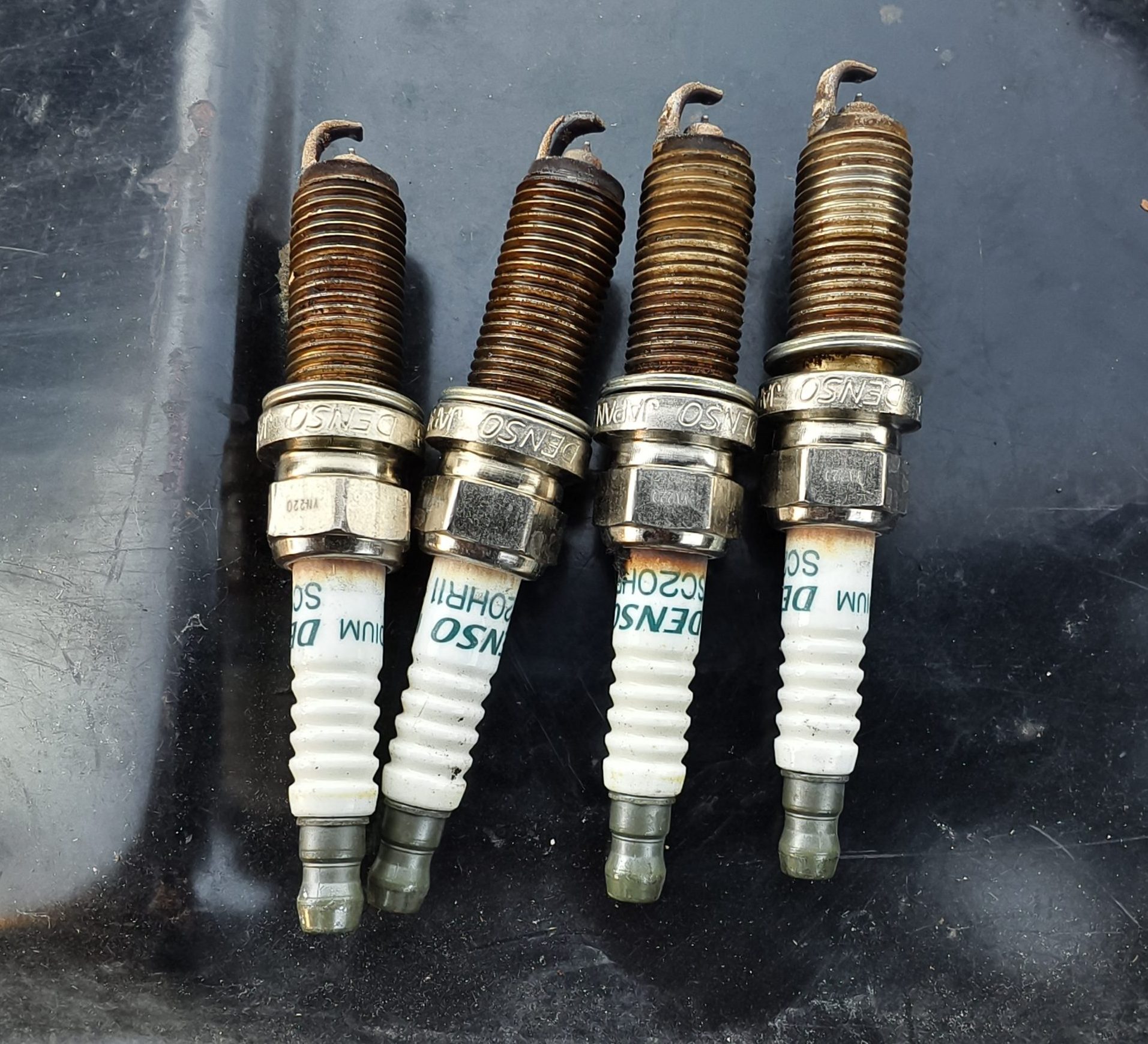
Enhance!

We replaced the plugs and the coils. Why? It was not fun getting to this point. We had to take off so many parts that our neighbors thought we were scrapping the little car.
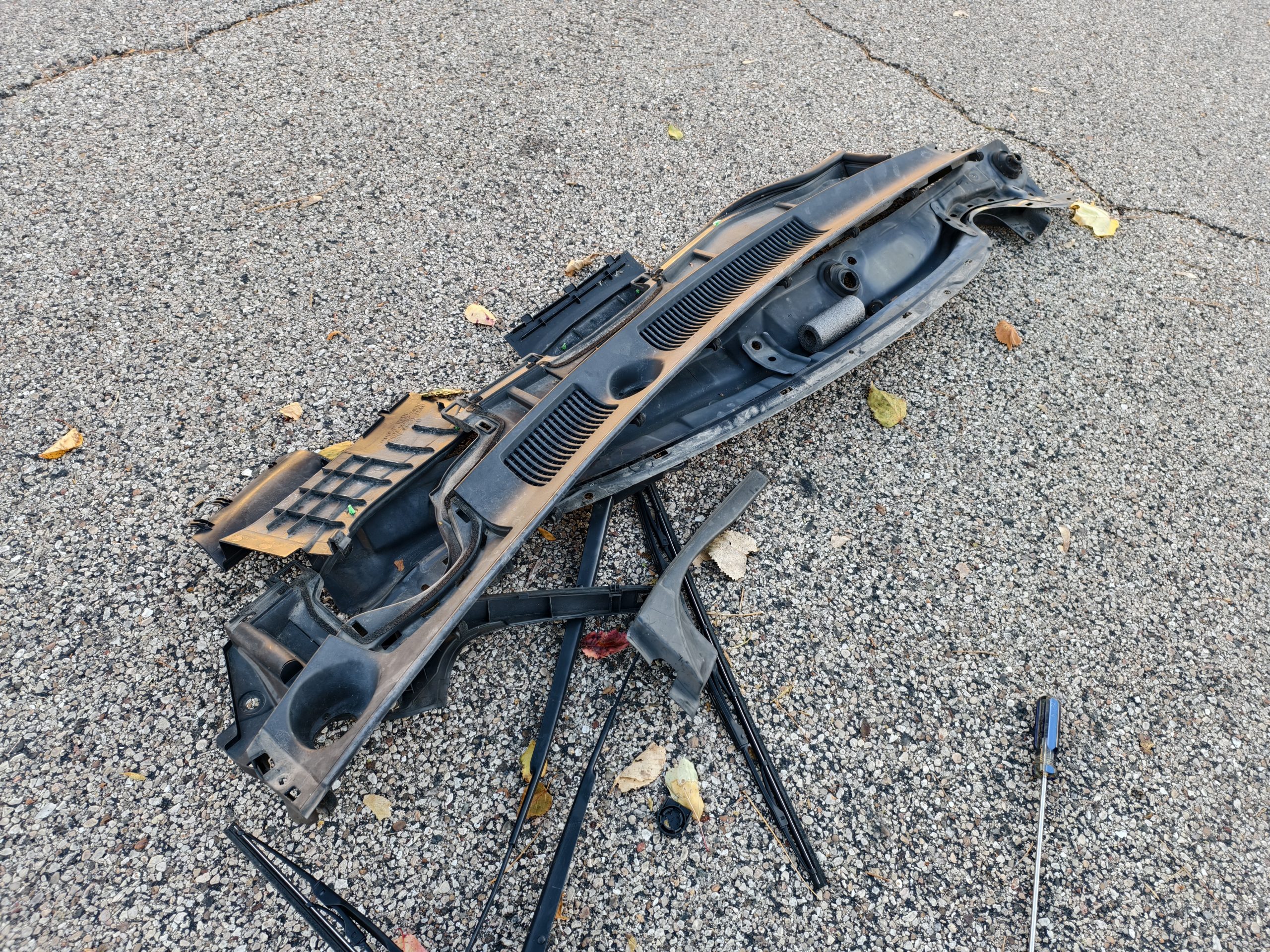
Normally, I would say that you should replace coils when they break. Don’t fix what isn’t broken. However, most cars don’t make you work to get to their coils. Given how hard my wife is on her car, I have no idea how much life the coils have left. So, we replaced the coils just for peace of mind.

The old ones are sitting on a shelf as spares, and I hope we never have to use them. Don’t worry, the new plugs and coils that went in are OEM Denso ones. I really don’t want to have to do this project again anytime soon.
Buttoning the car back up was the reverse of removal, and I think that might have taken around 45 minutes. That was only because Sheryl somehow managed to lose one of the header panel bolts, and we spent a considerable amount of time looking for it and my missing socket.
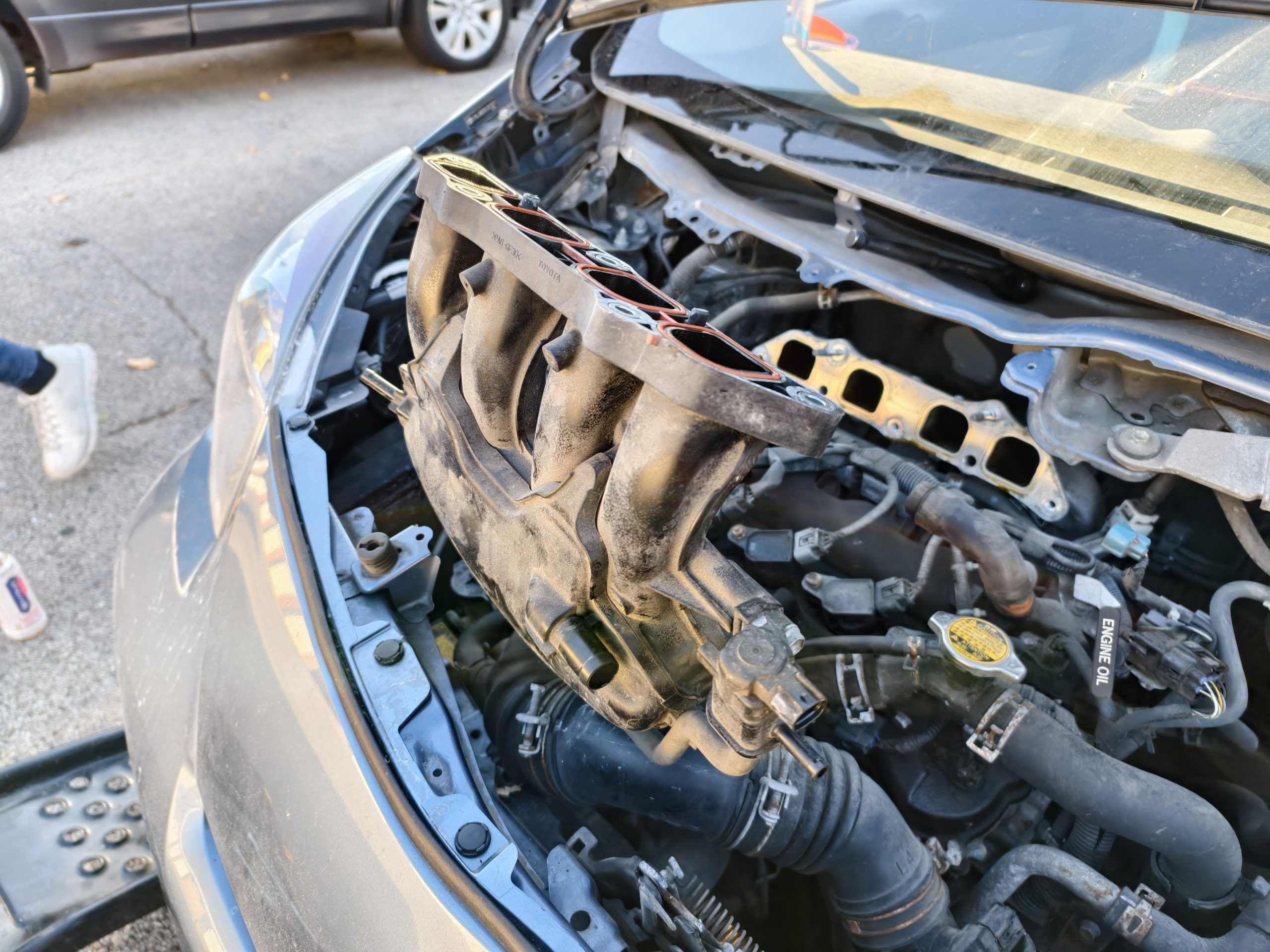
We wrapped up the day’s work by replacing the gas pedal, which took all of five minutes. I also studied the wiring diagram for the cruise control and, sure enough, I was right that a part of the unit is plug-and-play with the gas pedal. When I disconnected that part, it disabled the entire cruise control. The new pedal is in and is working great.
What was pretty cool is that it feels like the car is driving better than when we picked it up. It’s now scoring above 40 mpg at 60 mph, and is just as zippy as it should be. I’m not too surprised about this. I mean, the car had 67,000 miles on it when we picked it up, and the maintenance history wasn’t entirely clear on how the previous owner treated the car. Or, maybe it’s a placebo effect because the car’s been driving like crap for so long.

Better Than It Used To Be
Either way, the misfires are gone, the engine is no longer stalling, and the fuel economy is better than it was two years ago. So, I’m calling this one a solid victory. Also, I got to teach my wife how to do a project on her own car, and that always feels awesome. She got to feel the pride and gratification from fixing something, and got to save money doing it, too!

In total, we spent about $539. That’s $300 on the ignition coils, $207 for the gas pedal, and $32 on the spark plugs. That’s a lot of dough, but the dealer wanted $350 alone just to replace the gas pedal again and another $800 to do the spark plugs, so we saved big in doing it ourselves.
If you’ve ever been shocked by a dealership’s or mechanic’s quote, look into fixing your car yourself. You never know what you’re capable of doing. Just don’t be surprised if you own a modern car and find out that you have to go through a labyrinth to do a task that should be easy.
Top graphic images: Mercedes Streeter

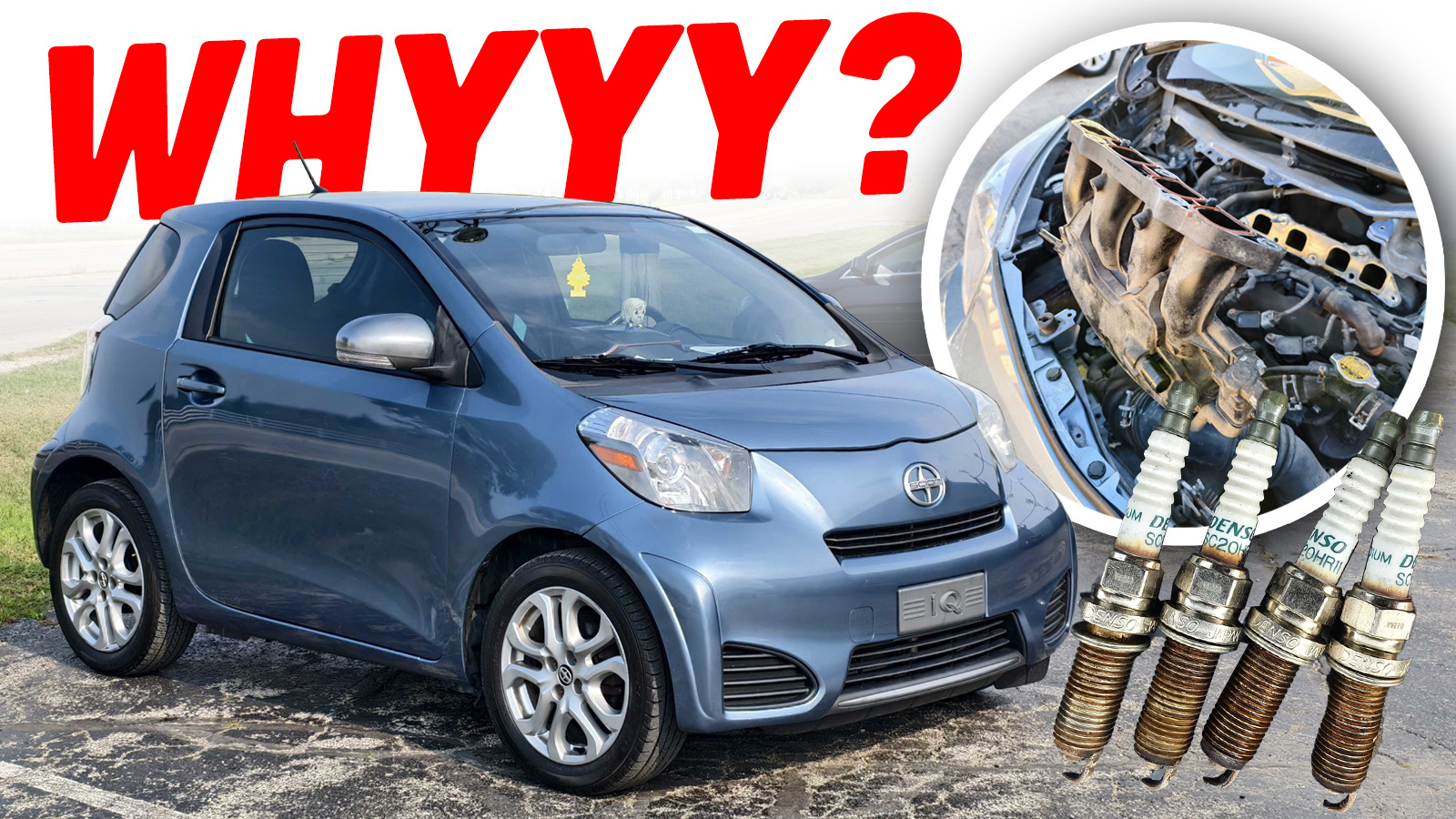







Anyone who has ever replaced the plugs on the rear bank of a transverse V-6 has done exactly this with a much larger intake manifold. I’ve done both a Kia Sorento and a Ford Escape that took more time in disassembly than replacing the plugs themselves.
Subarus are notoriously difficult due to space – only the exact combination of extensions and sockets will extract a plug from an H4.
The only cars that are easy are I-3/I-4s in economy sedans and SUVs.
The J35 in hundreds and thousands of Hondas and Acuras is by FAR the easiest transverse V-6 to change plugs on, no intake manifold in the way!!
The old GM 3800 rear plugs weren’t bad, but yeah otherwise transverse V6s are awful to work on.
I had a Legacy for a while too and yeah can confirm, I had to put in the socket, then attach a 3″ extension, then another, then plug the ratchet onto the end and then you could get the plug unscrewed, then had to take it out piece by piece. I hated that car.
My Tacoma had a wide open engine bay since I had the 4cyl but the intake still ran right across the top of the engine. I had to remove it to get to the 2 middle plugs and coils.
As someone who worked as a mechanic in the last 15 years, I find it funny that so many people still seem surprised by cars that have the intake over the spark plugs. Plenty of cars have been built that way going back to the 90s.
And this is why the Good Lord created iridium.
Great story, love it!
Reminds me of the time I needed plugs, wires and coil packs for an ancient BuICK Rendezvous. I ended up taking it to a shop to get that work done because to be able to access the rear set on the transverse V6 in a very tight engine compartment, the service manual says get out the hoist, take off the motor mounts, pull the engine up and out a bit and go from there. I didn’t have my own hoist at that point, so the local mechanic got a nice $650 from me. This was probably around 2012 or so. The same work would likely be well over a grand now for some relatively cheap parts, but the labor rate has skyrocketed.
“Also, when was the last time you took longer than maybe 30 minutes to remove and replace some spark plugs?” more than I would like to admit. pretty much every engine Ford with OHC setup has the flop over part of the intake covering the rear or in the older cases drivers side the result it the need to remove part of the intake to remove plugs. Old F-Bodies are nearly as tight as the old mustangs and thus accessing the rear plugs is usually requiring a lift or a creeper to pull them from under neath. The worst for me though was a Subaru Flat four. I am pretty sure I spent a couple hours just search for the odd Metric sized plugs, nobody make a 14mm with a plug holder inside, and they put the frame horn about 3 inches from the hole the plug goes into in the head. Then you have to do some tricky extension magnet to just get the socket into the hole and pule them apart in 3 pieces to just get the one plug out. What a terrible design that is. of course even when the plugs are front and center on hemi’s, there is still 16 of them so 30 minute swaps is unlikely there too.
Non-Turbo Subies are far easier; the plugs go in the top at an angle.
Tradeoff: The spark plug tubes fill with oil about every 30k, and it’s a non-turbo Subie.
That’s because of the SOHC, not the turbo. Legacy turbos also had plugs like that because they were single cam. It’s the DOHC that places them next to the frame rails, which includes non-turbo cars.
When I was a kid, the family had an ’81 (IIRC) Chevy Malibu Classic – 4dr with a 229cid V-6 and RWD. The recommended spark plug replacement procedure was to jack up the front, remove the wheels, and go in through the fenderwells. 😐
My motto for projects in general is actually “it’s better than it was”. 😀 If I were inclined to get tattoos, that would be near the top of the candidate list.
I think some of the new Garagntua pickups should do it this way too. you need a step ladder to just check the oil. you will be basically hanging upside down in there for plugs I bet.
Spark plug change in my Fiesta ST took half a day vs wife’s Outback taking less than an hour.
The Fiesta seems to require some non-existent thin wall spark plug socket. Tried griding the hardened steel, then tried to buy a new thinner socket from a store, then went back to grinding,
Awesome final pic!
As for the rest…
I like my cars too much to trust them in my own hands, especially the engine. Oh, an occasional replacement of a headlight or replacing the audio deck, sure (lost a 10mm doing that once).
I can’t remember the last time it’s taken me less, apart from my mower or my UTV.
Everything automotive I’ve changed plugs on in the last decade has either had 8+ cylinders, had a transverse V6, or been a Subaru.
I believed you as soon as you said Toyota. Changing the spark plugs on a 2005 Camry with the V6 also requires removing the intake manifold in order to reach the three in the back.
Did this on the lady friends Pacifica, same procedure. It’s not a Toyota thing, it’s a transverse V6 thing, but surprising on a 4cylinder to be sure.
Sounds like iQ should stand for I quit. Don’t give up hope on that 14mm. I once dropped a socket while working on my engine. Found it six years later.
I easily believe it. I’ve done similar work on other (larger) Toyotas, i.e. two Gen3 Prius and one 2005 Sienna and the plugs/coils were similarly hard to get at. All these vehicles required at least removal of the wipers, windshield cowling, and air intake to get at all the plugs and coils. Maybe that’s just the Toyota Way?
I’ve been avoiding doing the plugs on my Sorento because you have to remove the intake manifold, and I am very lazy. I also hate the car with a passion, so I avoid expending labour on it whenever possible.
‘Tis the same for my wife’s 2013 Sienna. The front plugs are easy-peasy, but the rears require the upper intake and the cowl parts to come off. At least they spec’d plugs that only need to be replaced after 196,000 kms. You’d better believe I’ll be doing the coils at the same time if we still have the car.
Meanwhile, the plugs on my Sonata took half an hour.
As for the 14mm socket, Christmas is coming, and a new one would be a great stocking stuffer.
Same, I was shocked how hard it was to access those rear 3 plugs in our old Sienna
“Next came the metal panel, and this one was also easy to remove, as it consisted of a handful of easily accessible 10mm bolts.”
Props to you and Sheryl for not losing the 10mm socket!! That 14mm deep socket being lost is such an outlier but probably satisfied the gods as a sacrifice in lieu of the traditional 10mm socket.
After seeing Sheryl sing your praises re: working on her iQ on Bluesky over the weekend I was hoping for a writeup here on the Autopian so thumbs up! 🙂
It had been a while since i had done any wrenching myself, so last time i did a spark plug job, the gods were angry and i lost not one but two 10mm sockets. the gods were thus appeased.
After years working on 5-series BMWs, I hated how crammed the engine bay of a six-cylinder 3-series was. This just makes me weep to think about.
“You Won’t Believe How Stupidly Difficult It Was To Replace The Spark Plugs In My Cheap Toyota”
After taking one look at the hood I bet I will
Pedantic Pet Peeve Rant. And I’m not picking on Mercedes here; tons of people do this.
A bolt that requires a 10mm wrench or socket to turn it is not a “10mm bolt”. It’s almost certainly a 6mm bolt, also called an “M6 bolt”. Threaded fasteners are (generally) not described by the tool used to turn them (eff you, Whitworth).
I don’t know why this bugs me so much, but it really does.
From the perspective of a tech, you refer to the bolt by socket size on disassembly, but the actual fastener size when getting new hardware.
So the service manual tells you to remove a 10mm bolt and replace it with an M6x1.0x15mm bolt? That’s a thing I’ve never heard before, but I always like learning new things.
I guess it makes sense, given there’s no way to really know what size a bolt is while it’s installed.
No, documentation is a different matter. But if you’re giving verbal directions on a shop floor, that’s kinda the unwritten rule.
Just be glad you lost a 14mm and not a 10mm! Then you’d REALLY be pissed 😛
And at least the spark plugs are iridium, so you won’t have to replace them again for a long long time 🙂
Maybe even ruthenium might have been worth trying, if they’re available for your iQ. Those are supposed to last even longer and could possibly never need to be changed again!
The 14mm was just inflation taking it’s toll.
Doing the coils was absolutely the correct call here. I did the plugs on a friends 2010 Versa and also had to pull the intake manifold, throttle body, and intake tubing (And Battery!) to get to everything. At least on the iQ they had the excuse of no space, the Versa was simply designed with spite and malice towards it’s owners.
When I did the job on the friends Versa, she went against my strongly worded recommendation to do coils AND plugs, and only bought plugs because the “coils cost too much.” 3 months later I had to do the entire job again because the coils died. Long story short, if the plugs are going out and the car is 10+ years and 100k+ miles, just do the coils, odds are they’re nearly shot too. Also the 2010 era Versa is horrible, stay far far away.
I ignored misfires on my BMW and the unburned fuel eventually melted down and clogged the catalytic converters.
<looks at engine bay>
<believes>
Glad the true Toy Yota is back on the road and doing better. I love seeing those little Scion iQ’s out there, but I rarely see them now. I have spotted 2 around the area I live, but plenty more Smarts. I also have ironically spotted a working Th!nk City car near where I live, which I find a bit crazy considering how few are our there.
Wow! wow, wow, wow………wow.
Old, crusty spark plugs are tight!
“Get all the way off my back about the 14mm socket thing”.
I will stop here.
I understood that reference. 🙂
????
Do not know why the the question marks posted as I had pasted a happy emoji face back to you.
Do not know why the the question marks posted as I had pasted a happy emoji face back to you
I picture a group of 10mm sockets with a heavenly cloud behind them, welcoming your 14mm socket to the Pearly Gates.